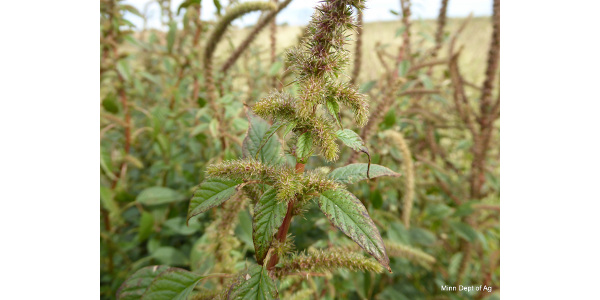Suspicious plants should be reported to the MDA
ST. PAUL — The Minnesota Department of Agriculture (MDA) is encouraging farmers and agronomists to scout fields now for the invasive weed Palmer amaranth.
Palmer amaranth is listed as a noxious weed in Minnesota and was first discovered in the state in 2016. All above and below ground parts of the plant must be destroyed, and it cannot be moved.
Left uncontrolled, a single female Palmer amaranth plant typically produces 100,000 to 500,000 seeds. It is resistant to multiple herbicides, can cause substantial yield losses, and greatly increase weed management costs in soybeans and corn.
Now is the time when Palmer amaranth is visible in agricultural fields. The MDA is asking farmers and agronomists to pull out any suspicious plants and report them to the Minnesota Department of Agriculture’s Arrest the Pest line at 1-888-545-6684 or arrest.the.pest@state.mn.us.
Palmer amaranth can be identified by the following characteristics:
- The green leaves are smooth and arranged in an alternate pattern that grows symmetrically around the stem. The leaves are oval to diamond or triangle shaped.
- The leaves of some Palmer amaranth plants have a whitish, V-shaped mark on them. Not all Palmer amaranth plants display this characteristic.
- Palmer amaranth looks similar to our native pigweeds such as waterhemp (tuberculatus and A. rudis), Powell’s amaranth (A. powellii), and redroot and smooth pigweeds (A. retroflexus and A. hybridus, respectively). Here are some distinguishing characteristics:
- Redroot and smooth pigweeds have fine hairs on their stems and leaves. Palmer amaranth and waterhemp do not have these hairs.
- The petiole (stalk connecting a leaf to the stem) is longer than the length of the leaf. For waterhemp, the petiole will be only half the length of the leaf.
- Seedhead spikes on female Palmer amaranth plants are much taller (up to three feet long) and pricklier than waterhemp or redroot and smooth pigweed spikes.
The invasive weed is also listed as a prohibited weed seed in the state. This means no Palmer amaranth is allowed in any seed offered for sale in Minnesota.
Palmer amaranth has been found in nine Minnesota counties; however, most of the sites have been successfully eradicated and the remaining are being closely monitored. Details of previous finds can be found on the MDA website.
Find more photos and information on Palmer amaranth here.
Last modified: 09/23/2020












